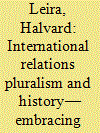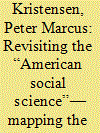| Srl | Item |
| 1 |
ID:
137603


|
|
|
|
|
| Summary/Abstract |
This article approaches the possibility of achieving pluralist International Relations research through engagements with history/History. There are serious sociological and disciplinary challenges to achieving pluralism, most importantly related to the need to make a mark and a career in one specific discipline and the constant diversification of disciplines. Even so, drawing on the literature of amateurism, understood as engaging in an activity for the love of it, it is argued here that a spirit of engaged amateurism in dealing with history offers an important opportunity for exploring commonalities and fostering pluralism both within the discipline and across disciplinary boundaries.
|
|
|
|
|
|
|
|
|
|
|
|
|
|
|
|
| 2 |
ID:
140874


|
|
|
|
|
| Summary/Abstract |
This paper studies the geography of the International Relations (IR) discipline, particularly the notion that IR is an “American social science.” First, it analyzes bibliometric data and finds that US-based scholars continue to dominate IR journals, but also that IR is one of the least US-dominated social sciences and that it has become markedly less so since the 1960s. Second, the paper argues that conventional measures based on nation-state affiliation capture only part of the spatial structures of inequality. It employs novel visualization tools to present an alternative map of elite stratification in IR. Instead of looking at national cores and peripheries, it maps the social network structures of authorship and coauthorship in key IR journals. By mapping city and institutional output, it finds stratification structures within the American discipline. Elite institutions in Northeast America, rather than “America,” dominate the field's leading journals. A similar stratification is found in Western Europe. Moreover, network linkages in terms of both coauthorships and doctoral backgrounds tie these Northeast American and West European elites together. The paper concludes that while US dominance in IR journals is in decline, this has not yet made the discipline as international as its name warrants.
|
|
|
|
|
|
|
|
|
|
|
|
|
|
|
|